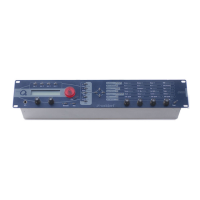Sound Parameters – Effects
93 Waldorf microQ User´s Manual
Vocoder
The Vocoder effect is a special effect type. Only one Vocoder is allowed at a time. When you
have several sounds using a Vocoder, the one in the lowest Instrument slot wins. E.g., if you
have a sound with a Vocoder effect set up for Instrument 1 and another sound with a Vocoder
in Instrument 3, only the Vocoder in Instrument 1 works.
A Vocoder is a circuit to process the frequency content of one signal with the frequency content of
another signal. This is done by splitting up the analysis signal (also known as Speech signal) with
bandpass filters into several frequency bands. The volume of each frequency band is then evaluated
with an envelope follower, and the resulting envelope is used to control the volume of a bandpass
filter that processes the synthesis signal (also known as Carrier signal). The synthesis signal is therefore
filtered by as many bandpass filters as the analysis signal, so that each analysis filter finds its synthesis
filter counterpart.
This technique was developed as early as World War II, but the plan then was to use it to encrypt
speech when transmitted by radio, rather than using it to create musically useful sounds. However,
this shouldn’t disturb you and you should feed a Vocoder with speech, drum loops or any other
collection of external audio material you like. The results will always be complex and interesting,
sometimes close to the original signal and sometimes much altered. Experiment and have fun.
For the Vocoder, you always need two signals, a signal that is analyzed and another signal that is
used for processing by the synthesis filters. The analyzed signal always comes from a different source,
either the external input or one of the internal routing busses. The synthesis signal is the current
sound, but if you wish to use a different synthesis signal, set up the N/E Select parameter in the
Mixer/Routing Edit menu to feed the filters with the External In or one of the internal routing busses. It
might even be interesting if both the analysis and synthesis signal come from the same source,
especially when you set the synthesis band offsets to other values than +00. Then a low analysis band
might deliver the envelope for a high synthesis band and vice versa.
To preserve the original signal as much as possible, the synthesis signal should only consist of a
simple, unfiltered noise that you generate with the microQ’s noise generator. For a spoken or sung
voice, you should add a sawtooth oscillator such that the pitch determines the frequency of the
speech. To get a natural sounding spoken voice, you should modulate the pitch of this oscillator with
a slow sine LFO to simulate the emphasis.
Easy Setup for working with the Vocoder
☞ Building a Vocoder setup
1. Connect the audio input of your microQ with a 1/4-inch mono or stereo plug. In practice, a
socalled “insert” or “Y” cable is perfect for a stereo or dual mono signal input for the
vocoder. Please be sure to use a line signal. If you want to use a microphone be sure to use
a pre amplifier to generate a line signal.
2. With the Input Gain parameter in the Global menu you can increase the sensitivity. Please
refer to the chapter „Global Parameters“ on page 130 for more details.
3. Select a sound program. We recommend the use of sustained pad or string sound.
4. Select the Vocoder as effect type for FX slot 1 or 2 and initialize the parameters. This is
done by holding the Shift button while moving the left or right display parameter dial:

